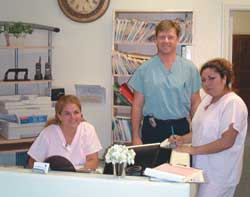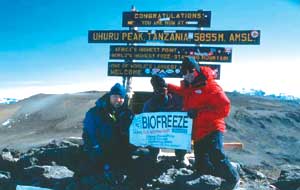We interviewed eight representatives from the leading manufacturers of chiropractic tables to find out what’s new and what makes each company unique. From new, electronic features and tables made for specific techniques to tables that adapt to any technique, these companies, with a combined experience of almost 300 years, have something for everyone.
Lloyd Table Company
Lloyd Table Company is continually striving to make a table(s) that will meet all of the needs of today’s chiropractor, thus enhancing the health of the entire world through chiropractic care.
We know that most doctors use multiple techniques when they adjust. Our goal at Lloyd Table Company is to manufacture one table that will adapt to any technique, whether it is Activator, Flexion–Distraction, Thompson-type drops, Gonstead, CBP, SOT, Upper Cervical, Decompression or any other technique.
We pride ourselves on using cutting edge technology to help make the adjustment process easier. Some of the many new tables/features we are working on are:
• CBP-Type Drops, Elevating head & chest
• Drop Ankle–Manual & Automatic Cocking (extremity adjusting)
• Galaxy 905HS—This table has the capability to hylo & elevate in just over 8 seconds. The 905HS has an incredible height range from 18″ to 38″
• Galaxy McManis Elevation 05—This table has the capability to elevate from 18″ to 38″ with up to 24 degrees of flexion.
Lloyd A. Steffensmeier, DC, is President and CEO Lloyd Table Company, one of the largest manufacturers of chiropractic adjusting tables in the world, located in Lisbon, Iowa. Dr. Steffensmeier began manufacturing equipment in 1963 from the basement of his Mt. Vernon practice and the company has steadily grown to encompass an approximately 50,000 square foot facility. For more information on Lloyd Table Company, call 800-553-7297/319-455-2110, or visit www.lloydtable.com.
Eckard HealthTables
I invented motorized flexion distraction, in 1981. I first built tables we named Leander. Then, after a few years of great success and professional acceptance, I sold the company to a Wall Street tycoon type, who proved his superior intellect and left me talking to myself.
After five years, I designed a new table that also incorporated flexion distraction and some new concepts, which have since been proven very effective treating patients. The mission of my efforts, as the principle of my company, has always been to serve the chiropractic profession and provide the best equipment and seminars possible.
Actually, I have long since developed a superior adjusting technique to reduce subluxations using the flexion distraction motion to assist in making the spinal corrections during motion.
The newest feature in my table is the two step pelvic drop device, which allows the doctor to correct just one sacroiliac articulation without insulting the integrity of the other sacroiliac articulation.
Dr. Leander Eckard graduated from Cleveland College of Chiropractic in Kansas City in 1964. He practiced chiropractic in his home state of Washington for 30 years. Since surviving a crash in a personal airplane in 1990, he has limited his practice to demonstrations at Parker Seminars and various State seminars. He presently lives in Idaho with his wife of 13 years, Diane.
Elite Chiropractic Tables
Elite Manufacturing has been in the chiropractic industry for over 30 years. Our chiropractic tables are considered to be the workhorses of the industry. Our mission is to provide chiropractors with the very best tables at a great price.
Our tables have been designed with a variety of techniques in mind, including but not limited to, Thompson, flexion-distraction and diversified. With the majority of chiropractors practicing a form of diversified technique, we have found that our tables will suit most, if not all, techniques being used by today’s chiropractor.
We have recently developed the ET Flex table (electric tension controlled flexion table). This table allows chiropractors to adjust the flexion with just a tap of a foot switch. This feature is superior to the manual tension control, which can be awkward and time-consuming. We have also developed our own distraction table, which allows the doctor to create axial tension in the lumbar spine. These features are allowing chiropractors to treat a wider variety of patients.
For more information, call Elite Chiropractic Tables, 800-689-4730; email [email protected]; or visit www.elite-chirotables.com.
Health Care Manufacturing, Inc. (HCMI)
The support of the chiropractic profession is the number one priority at HCMI. We take great pride in offering the highest quality X-ray systems, chiropractic adjusting tables and electro therapy units. HCMI will continue to develop new and exciting product innovations in an effort to supply chiropractors with the tools to grow their profession.
HCMI manufactures a full line of chiropractic adjusting and therapy tables. It is this diversity that insures that we can build a table suited for just about any of your clinical needs.
Since 1989, HCMI has designed, manufactured, and marketed a wide range of products to the chiropractic profession. Starting as a table manufacturer, HCMI’s growth and popularity allowed an expansion of the product line to include electro therapy units and, starting in 1999, 100 kHz high frequency radiographic systems. This has given HCMI the most comprehensive product line manufactured under one roof and the convenience of one stop shopping.
Rob Brice is a regional sales manager of Health Care Manufacturing. For more information about HCMI, call 800-641-4107/417-864-6511, or visit www.healthcaremfg.com.
Williams Healthcare
For nearly 100 years, Williams Healthcare Systems continues to lead the world in developing, manufacturing and marketing Zenith chiropractic adjusting instruments, and related products that enable the doctor to provide a consistent level of high quality healthcare delivery to their patients throughout the life of their practice.
To that end, the company shall always endeavor to delight its customers with products and services which result from good manufacturing practices, ethical decision-making and on-going efforts to continuously improve the products, processes and services to achieve that objective, every day!
Our chiropractic tables are designed to support the practice of the generalist all the way through to the specialist.
Our Zenith adjusting instrument family compliments the widest range of multiple technique clinics, because they were designed by great innovators of chiropractic technique.
The NEW Zenith III table family incorporates state-of-the-art electronic control systems, auto-cocking “Terminal Point” airdrops, the supple “Sensation” upholstery and a product warranty that is unmatched in the industry.
The company is also very proud to offer the family of motorized flexion distraction tables designed and built to the demanding specification of Leander J. Eckard, DC, and has recently brought on-board the phenomenal work of two doctors, Dennis Woggon, DC, related to scoliosis treatment and chiropractic vibrating therapy and Arthur Copes, PhD, related to scoliosis treatment, bracing and nutritional management. In addition, the company is offering a brand new suite of Gonstead adjusting instruments that feature a clean and beautiful aesthetic design, rugged construction and uniquely-important features that will no doubt delight the Gonstead practitioner.
Thomas J. Kenny is President & CEO of Williams Healthcare Systems. For more information on Williams Healthcare Systems, call 847-741-3650, or visit www.williams-healthcare.com.
Hessco
The Schultz family has been serving the chiropractic table market for 45 years. My brother, Doug, and I grew up attending chiropractic conventions and working on chiropractic tables. The third generation has now begun serving the chiropractic profession.
Hessco has grown from 1 location with 3 employees to 13 locations and 65 employees by offering service after the sale. Our service techs average over 18 years of experience. Hessco also offers the chiropractor a choice of many table brands. This allows us to help find the table that is right for the doctor. As the world’s largest dealer for Leander, Lloyd, Zenith, Chattanooga, and Aquathermassage, Hessco is trusted by these table companies to provide world-class customer service. Hessco also offers tables from 20 other table manufacturers. We have over 500 used tables in stock, all of which will be completely reconditioned with the doctor’s choice of colors. Reconditioned tables come with up to a 2-year parts warranty.
We are able to offer many different models that will fit all techniques.
The chiropractic table business is constantly changing and growing. Our sales reps are always undergoing training to keep up with the many new products continually entering the market.
David Schultz is the owner of Hessco. For more information about Hessco, call 800-237-5652, or visit www.hessco.com.
LSI International
We, at LSI, have adopted the phrase Loyalty, Service and Integrity, to go along with the initials of our company. These three words truly exemplify our mission statement. We strive to build the highest quality, most reliable products on the market, while being loyal to the profession by providing exceptional customer service and always being honest in our business dealings with both our vendors and customers.
Since the table we manufacture is the Quantum 400 Intersegmental Traction table, there aren’t really any particular adjusting techniques that are used with it. Its primary function is to cause separation of the vertebra and to elongate and relax the trapezius, erector spinae and paraspinal muscles. This will help ease pain and spasm and make it easier for the doctor to adjust the patient.
Instead of moving the roller carriage on our table using rubber casters, we now use a rail system. We have the exclusive LSI Glide-Trak system, which consists of four permanently lubricated blocks that glide effortlessly over a polished steel rail. This eliminates the problem of the rubber casters wearing away and becoming very noisy and messy.
Mark Reiter is the Senior Vice-President of LCI International. For more information, call LSI International at 800-832-0053l, or visit http://www.lsiinternational.com.
EuroTech
Eurotech is one of the few table companies to be owned by a practicing DC, who knows and understands the problems and rewards in treating patients through chiropractic.
Our goal is to make the best tables available at the best price. As Eurotech’s owner, I will personally guide the doctor through his or her buying experience to make it as smooth and easy as possible, and then work with the doctor after the sale to help him or her get the most benefit from their new table.
Any form of flexion-extension therapy works well on the Eurotech tables. We furnish technique manuals as well as a thorough DVD, in order to teach the doctor always to get the most benefit from their new table. The doctor can use diversified and drop techniques as well. Eurotech tables can do double and triple duty as exam and therapy tables.
R.A.D., or Remote Access Distraction, now allows the doctor not only to do long axis distraction, but cycled spinal decompression easily and quickly through the use of the R.A.D. digital control module. This feature rivals tables costing ten to twenty times more. We also have the new R.A.D. II headpiece that permits cervical distraction as well as cervical flexion. We are very excited about a new feature called “E.W.T.”, or Euroflex-Wave-Technology. This new design will make flexion even easier for the doctor and the patient alike and, yet, still cost less than any electric flexion table on the market!
Dr. Gary Huddleston is the owner and C.E.O of Eurotech Mfg. His current practice is composed only of the film, entertainment, music industry and professional athletes.

 Having practiced in California for the past 20 plus years, Dr. Pugsley now has two multi-disciplinary clinics that offer services of chiropractic, orthopedics, neurology, acupuncture and massage. In both offices, Dr. Pugsley has a family practice with an emphasis on automobile accident cases, Workers Compensation and trauma.
Having practiced in California for the past 20 plus years, Dr. Pugsley now has two multi-disciplinary clinics that offer services of chiropractic, orthopedics, neurology, acupuncture and massage. In both offices, Dr. Pugsley has a family practice with an emphasis on automobile accident cases, Workers Compensation and trauma. M$C: Do you have a favorite “patient success” story?
M$C: Do you have a favorite “patient success” story?



 M$C: Any final words or advice for our readers?
M$C: Any final words or advice for our readers?
 Isenberg: At this time, we work with all major state associations and colleges. We have a Biofreeze Scholarship at Logan Chiropractic College and at the new chiropractic school at Florida State University. Gail Wiley, our Corporate Development Manager, is currently talking with all colleges to expand our scholarship program.
Isenberg: At this time, we work with all major state associations and colleges. We have a Biofreeze Scholarship at Logan Chiropractic College and at the new chiropractic school at Florida State University. Gail Wiley, our Corporate Development Manager, is currently talking with all colleges to expand our scholarship program.
 Cooper: There are many fine products within our marketplace that can be purchased from a variety of supply companies. Finding the best source for the products that will help your practice largely comes down to knowing as much as possible about the supplier before you actually purchase from them. You need to ask some questions before you buy and I am not just referring to large ticket purchases. (Consider these questions before buying supplies as well.)
Cooper: There are many fine products within our marketplace that can be purchased from a variety of supply companies. Finding the best source for the products that will help your practice largely comes down to knowing as much as possible about the supplier before you actually purchase from them. You need to ask some questions before you buy and I am not just referring to large ticket purchases. (Consider these questions before buying supplies as well.)